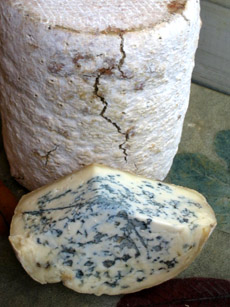
 Born in the U.S.A.: Bayley Hazen Blue is made by Andy and Mateo Keehler of Jasper Hill Farm in Vermont, in the style of the classic British Stilton but with its own distinct recipe. The Keehlers learned their craft at Colston-Bassett in Nottinghamshire. Born in the U.S.A.: Bayley Hazen Blue is made by Andy and Mateo Keehler of Jasper Hill Farm in Vermont, in the style of the classic British Stilton but with its own distinct recipe. The Keehlers learned their craft at Colston-Bassett in Nottinghamshire.
|
STEPHANIE ZONIS focuses on good foods and the people who produce them. KAREN HOCHMAN also contributed to this article.
|
|
December 2005
Updated September 2009
|
 |
Blue Cheese: In Praise Of The Blues
Page 1: An Introduction To Blue Cheese
This is Page 1 of a three-page article. Click on the black links below to visit other pages.
Blue Cheese Overview
These aren’t the blues of B. B. King, nor are they the notorious holiday blues. I refer, of course, to blue cheeses. As a kid, there was no way I would voluntarily have eaten cheese with mold in it. But sometime during the period when I was discovering that foods such as asparagus and mushrooms were actually edible, my tastes in cheese changed, too. Now, I adore a good blue cheese. While I’ll go to great lengths to acquire such a product, I’d like to deny a story that I once smuggled an outstanding raw milk blue out of the U.K. into the U.S. (As it happens, that story is completely true, but I’d still like to deny it, because I’m not sure it was the brightest thing I’ve ever done.)
The cheeses aren’t blue, of course—they’re dotted with veins that are dark blue, blue-green, green or bluish-black. The veins are Penicillium molds—cousins of the antibiotic. The molds are also relatives of the bloomy mold that covers Bries and Camemberts. Blue cheeses were originally a natural product of their environment. For example, the caves of Roquefort sur Soulzon in southwest France are teeming with Penicillium roqueforti (the town gave its name to the cheese and the mold). Just place the cheese in the cave, and the mold would penetrate it. Today, the cheeses are produced on a large scale, so they’re injected with the mold in cheese factories. But more about that on the next page.
Blue cheese is ancient, and likely to be an accidental discovery. Cheeses were aged in caves; some caves had the right temperature, moisture and other natural conditions for certain strains of mold to develop, whether on the surface of the cheese or, in the case of blue cheeses, inside the cheese via air pockets in the cheese. Once cheesemakers realized what was happening, they created pinholes in the cheeses to help the mold penetrate the cheese more easily.
Of the three best-known blues, Gorgonzola is known to have been created around 879 C.E. in Italy although it is said that it did not have blue veins until around the 11th century. Roquefort is said to have been invented in 1070 C.E., in France. British Stilton was developed in the 18th century.
- Blue cheese can range from high moisture and creamy to firm and well-aged. The longer cheeses are aged, the more solid they become.
- Blues are a particularly complex type of cheese to produce. It’s easy for the levels of both salt and mold in a blue cheese to go haywire. Even planned mold growth inside a blue causes radical change in the pH of the product, as well as alterations in the fats and proteins.
- The most venerable and famous blues—Gorgonzola, Roquefort, Stilton plus Spanish Cabrales—are D.O.P. or A.O.C. protected. But there are dozens and dozens of prominent blues, including Bleu de Bresse and Bleu d’Auvergne (France), Danablu (Denmark), Blue Cheshire (England), and a good number produced in the United States, beginning with the venerable Maytag Blue and many great blues that have won international awards.
- Some blue-veined cheeses can be found in the other categories—blue goat cheeses and double- and triple-crémes (Brie-types), for example. It’s possible to produce a blue in almost every cheese category except for fresh cheeses.
How do those delicious veins of blue get into the cheese?
Continue To Page 2: How Blue Cheese Is Made
Go To The Article Index Above

|




